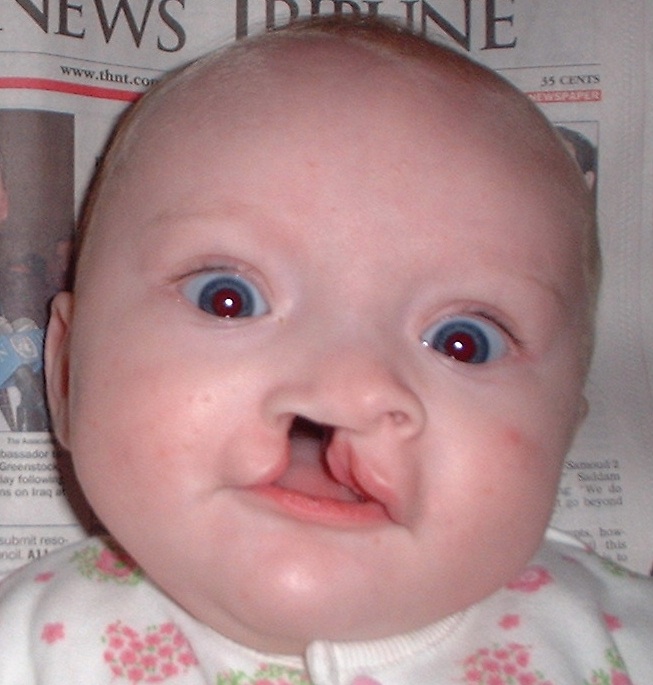Malpuech facial clefting syndrome
Editor-In-Chief: Prab R Tumpati, MD
Obesity, Sleep & Internal medicine
Founder, WikiMD Wellnesspedia &
W8MD medical weight loss NYC and sleep center NYC
| Malpuech facial clefting syndrome | |
|---|---|

| |
| Synonyms | Malpuech syndrome |
| Pronounce | |
| Specialty | Medical genetics |
| Symptoms | Facial clefting, developmental delay, hearing loss, genitourinary anomalies |
| Complications | N/A |
| Onset | Congenital |
| Duration | Lifelong |
| Types | N/A |
| Causes | Genetic mutation |
| Risks | |
| Diagnosis | Clinical examination, genetic testing |
| Differential diagnosis | Orofaciodigital syndrome, Van der Woude syndrome |
| Prevention | |
| Treatment | Surgical intervention, supportive care |
| Medication | |
| Prognosis | Variable |
| Frequency | Rare |
| Deaths | |
Malpuech facial clefting syndrome is a rare genetic disorder characterized by specific facial features, growth retardation, intellectual disability, and other physical abnormalities. The syndrome is named after the French pediatrician who first described it in 1983, Michel Malpuech.
Symptoms and Signs[edit | edit source]
The most common symptoms of Malpuech facial clefting syndrome include cleft lip and cleft palate, micrognathia (small lower jaw), microcephaly (small head size), and hypertelorism (widely spaced eyes). Other features may include growth retardation, intellectual disability, hearing loss, and heart defects.
Causes[edit | edit source]
Malpuech facial clefting syndrome is caused by mutations in the COLEC11 or MASP1 genes. These genes are involved in the development of the face and other parts of the body. The syndrome is inherited in an autosomal recessive manner, which means both copies of the gene in each cell have mutations.
Diagnosis[edit | edit source]
Diagnosis of Malpuech facial clefting syndrome is based on the clinical features and confirmed by genetic testing. Genetic counseling is recommended for families who have a child with this syndrome.
Treatment[edit | edit source]
Treatment for Malpuech facial clefting syndrome is symptomatic and supportive. It may include surgery to repair the cleft lip and palate, speech therapy, and educational support for intellectual disability.
Prognosis[edit | edit source]
The prognosis for individuals with Malpuech facial clefting syndrome varies depending on the severity of the symptoms. With appropriate treatment and support, many individuals with this syndrome can lead a normal life.
Gallery[edit | edit source]
See also[edit | edit source]
Search WikiMD
Ad.Tired of being Overweight? Try W8MD's NYC physician weight loss.
Semaglutide (Ozempic / Wegovy and Tirzepatide (Mounjaro / Zepbound) available. Call 718 946 5500.
Advertise on WikiMD
|
WikiMD's Wellness Encyclopedia |
| Let Food Be Thy Medicine Medicine Thy Food - Hippocrates |
Translate this page: - East Asian
中文,
日本,
한국어,
South Asian
हिन्दी,
தமிழ்,
తెలుగు,
Urdu,
ಕನ್ನಡ,
Southeast Asian
Indonesian,
Vietnamese,
Thai,
မြန်မာဘာသာ,
বাংলা
European
español,
Deutsch,
français,
Greek,
português do Brasil,
polski,
română,
русский,
Nederlands,
norsk,
svenska,
suomi,
Italian
Middle Eastern & African
عربى,
Turkish,
Persian,
Hebrew,
Afrikaans,
isiZulu,
Kiswahili,
Other
Bulgarian,
Hungarian,
Czech,
Swedish,
മലയാളം,
मराठी,
ਪੰਜਾਬੀ,
ગુજરાતી,
Portuguese,
Ukrainian
Medical Disclaimer: WikiMD is not a substitute for professional medical advice. The information on WikiMD is provided as an information resource only, may be incorrect, outdated or misleading, and is not to be used or relied on for any diagnostic or treatment purposes. Please consult your health care provider before making any healthcare decisions or for guidance about a specific medical condition. WikiMD expressly disclaims responsibility, and shall have no liability, for any damages, loss, injury, or liability whatsoever suffered as a result of your reliance on the information contained in this site. By visiting this site you agree to the foregoing terms and conditions, which may from time to time be changed or supplemented by WikiMD. If you do not agree to the foregoing terms and conditions, you should not enter or use this site. See full disclaimer.
Credits:Most images are courtesy of Wikimedia commons, and templates, categories Wikipedia, licensed under CC BY SA or similar.
Contributors: Prab R. Tumpati, MD





